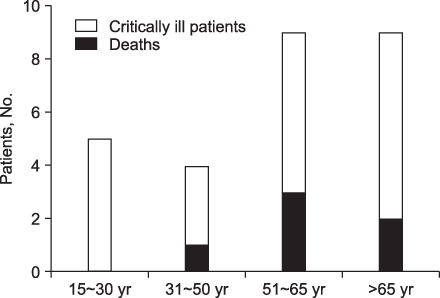Tuberc Respir Dis.
2011 Jan;70(1):28-35.
Critically Ill Patients with Pandemic Influenza A/H1N1 2009 at a Medical Center in Korea
- Affiliations
-
- 1Department of Respiratory and Critical Care Medicine, Asan Medical Center, University of Ulsan College of Medicine, Seoul, Korea. sbhong@amc.seoul.kr
- 2Department of Infectious Diseases, Asan Medical Center, University of Ulsan College of Medicine, Seoul, Korea.
- 3Department of Emergency Medicine, Asan Medical Center, University of Ulsan College of Medicine, Seoul, Korea.
- 4Department of Laboratory Medicine, Asan Medical Center, University of Ulsan College of Medicine, Seoul, Korea.
Abstract
- BACKGROUND
The aim of the study was to describe the characteristics, treatments, and outcomes of critically ill patients with pandemic Influenza A/H1N1 2009 at a major medical center in Korea.
METHODS
This retrospective observational study examined critically ill adult patients with pandemic Influenza A/H1N1 2009, who were admitted to the AMC between August and December 2009.
RESULTS
27 patients with confirmed pandemic Influenza A/H1N1 2009 were admitted to the intensive care unit (ICU) at the Asan Medical Center (AMC). The median age (IQR) was 59 years (41~67), and 66.7% of the patients were older than 51 years. A total of 81.5% of the patients had 2 or more co-morbidities. The median time (IQR) from symptom onset to presentation was 2 days (1~4), and the median time from presentation to ICU admission was 0 days (0~1.5). All patients received oseltamivir (300 mg/day) and 13 patients received triple combination therapy (oseltamivir, amantadine, ribavirin). Twelve patients required mechanical ventilation on the first day of ICU admission. A total of 6 patients (22.2%) died within 28 days of admission. The patients who died had significantly higher acute physiology and chronic health evaluation (APACHE) II and sequential organ failure assessment (SOFA) scores at presentation. There were no significant differences in age, co-morbidities, or antiviral regimens between survivors and non-survivors.
CONCLUSION
Critical illness related to pandemic Influenza A/H1N1 2009 was common in elderly patients with chronic co-morbidities. All patients were given high-dose oseltamivir or triple combination antiviral therapy. Nonetheless, patients with critical illnesses associated with pandemic Influenza A/H1N1 2009 had a death rate of 22.2%.
MeSH Terms
Figure
Reference
-
1. Centers for Disease Control and Prevention (CDC). Swine influenza A (H1N1) infection in two children--Southern California, March-April 2009. MMWR Morb Mortal Wkly Rep. 2009. 58:400–402.2. Global alert and response, pandemic (H1N1) 2009, frequently asked questions: what is phase 6? [Internet]. World Health Organization. c2011. cited 2011 Jan 10. Geneva: WHO;Available from: http://www.who.int/csr/disease/swineflu/frequently_asked_questions/levels_pandemic_alert/en/index.html.3. KCDC Newsletters [Internet]. Korea Centers for Disease Control and Prevention. c2011. cited 2011 Jan 10. Cheongwon: KCDC;Available from: http://www.cdc.go.kr/kcdchome/jsp/home/common/brd/COMMBRD0200List.jsp?menuid=100047&contentid=null&boardid=1010&appid=&pageNum=1&sub=1&sub2=2&tabinx=1&q_had01=A&q_had02=2011&loadType=null&boardseq=null.4. Domínguez-Cherit G, Lapinsky SE, Macias AE, Pinto R, Espinosa-Perez L, de la Torre A, et al. Critically ill patients with 2009 influenza A (H1N1) in Mexico. JAMA. 2009. 302:1880–1887.5. Kumar A, Zarychanski R, Pinto R, Cook DJ, Marshall J, Lacroix J, et al. Critically ill patients with 2009 influenza A (H1N1) infection in Canada. JAMA. 2009. 302:1872–1879.6. Louie JK, Acosta M, Winter K, Jean C, Gavali S, Schechter R, et al. Factors associated with death or hospitalization due to pandemic 2009 influenza A (H1N1) infection in California. JAMA. 2009. 302:1896–1902.7. Rello J, Rodríguez A, Ibañez P, Socias L, Cebrian J, Marques A, et al. Intensive care adult patients with severe respiratory failure caused by Influenza A (H1N1)v in Spain. Crit Care. 2009. 13:R148.8. Davies A, Jones D, Bailey M, Beca J, Bellomo R, Blackwell N, et al. Australia and New Zealand Extracorporeal Membrane Oxygenation (ANZ ECMO) Influenza Investigators. Extracorporeal Membrane Oxygenation for 2009 Influenza A (H1N1) Acute Respiratory Distress Syndrome. JAMA. 2009. 302:1888–1895.9. Hancock K, Veguilla V, Lu X, Zhong W, Butler EN, Sun H, et al. Cross-reactive antibody responses to the 2009 pandemic H1N1 influenza virus. N Engl J Med. 2009. 361:1945–1952.10. Vaillant L, La Ruche G, Tarantola A, Barboza P. epidemic intelligence team at InVS. Epidemiology of fatal cases associated with pandemic H1N1 influenza 2009. Euro Surveill. 2009. 14(33):pii.19309.11. Cooksley CD, Avritscher EB, Bekele BN, Rolston KV, Geraci JM, Elting LS. Epidemiology and outcomes of serious influenza-related infections in the cancer population. Cancer. 2005. 104:618–628.12. OECD factbook 2009: economic, environmental and social statistics. 2009. Paris: OECD.13. Chien YS, Su CP, Tsai HT, Huang AS, Lien CE, Hung MN, et al. Predictors and outcomes of respiratory failure among hospitalized pneumonia patients with 2009 H1N1 influenza in Taiwan. J Infect. 2010. 60:168–174.14. Zarychanski R, Stuart TL, Kumar A, Doucette S, Elliott L, Kettner J, et al. Correlates of severe disease in patients with 2009 pandemic influenza (H1N1) virus infection. CMAJ. 2010. 182:257–264.15. Abdel-Ghafar AN, Chotpitayasunondh T, Gao Z, Hayden FG, Nguyen DH, deJong MD, et al. Writing Committee of the Second World Health Organization Consultation on Clinical Aspects of Human Infection with Avian Influenza A (H5N1) Virus. Update on avian influenza A (H5N1) virus infection in humans. N Engl J Med. 2008. 358:261–273.16. Nguyen JT, Hoopes JD, Smee DF, Prichard MN, Driebe EM, Engelthaler DM, et al. Triple combination of oseltamivir, amantadine, and ribavirin displays synergistic activity against multiple influenza virus strains in vitro. Antimicrob Agents Chemother. 2009. 53:4115–4126.
- Full Text Links
- Actions
-
Cited
- CITED
-
- Close
- Share
- Similar articles
-
- A Case of Pandemic 2009 H1N1 Influenza A Manifestation as Apical Ballooning Syndrome
- A Fetal Case of Pandemic Influenza (H1N1 2009) by the Aggravated Heart Faiure
- The 2009 H1N1 Pandemic Influenza in Korea
- Epidemiology, clinical manifestations, and management of pandemic novel Influenza A (H1N1)
- Influenza Associated Pneumonia


